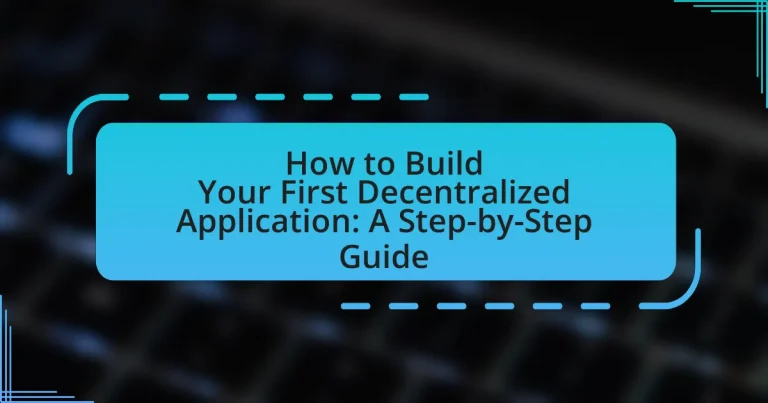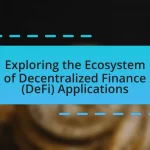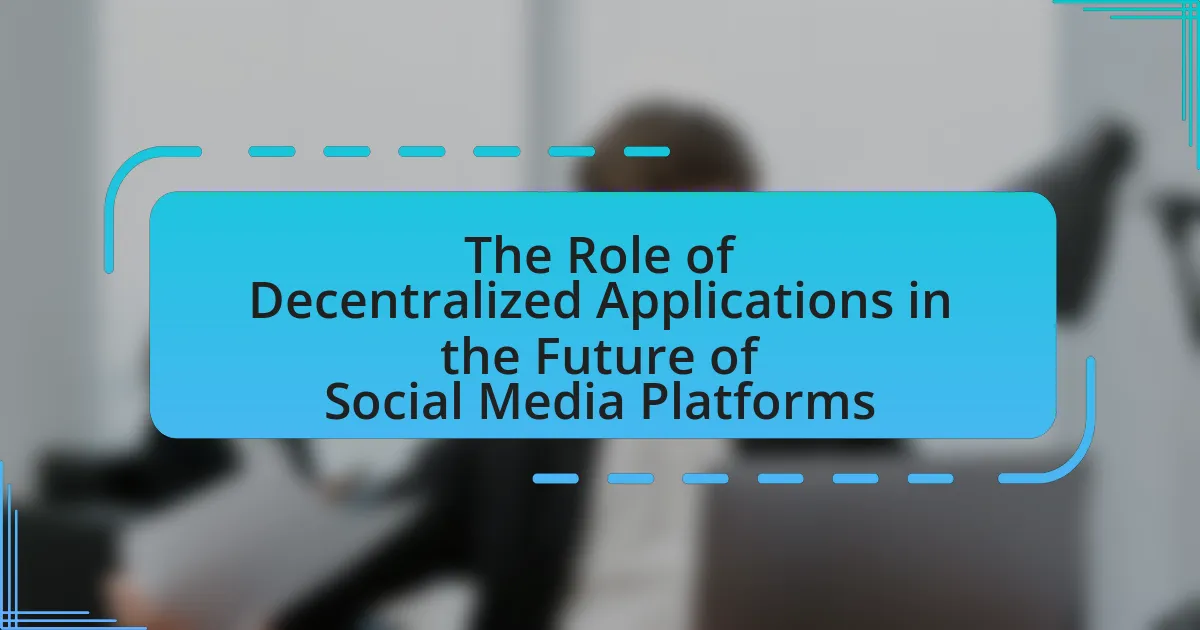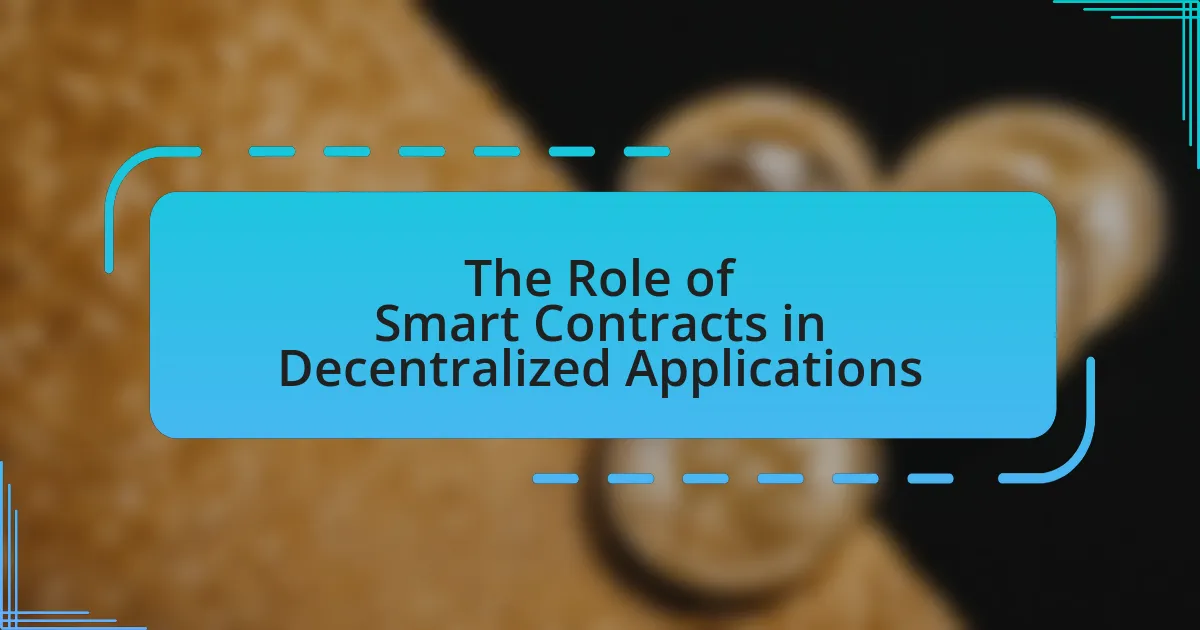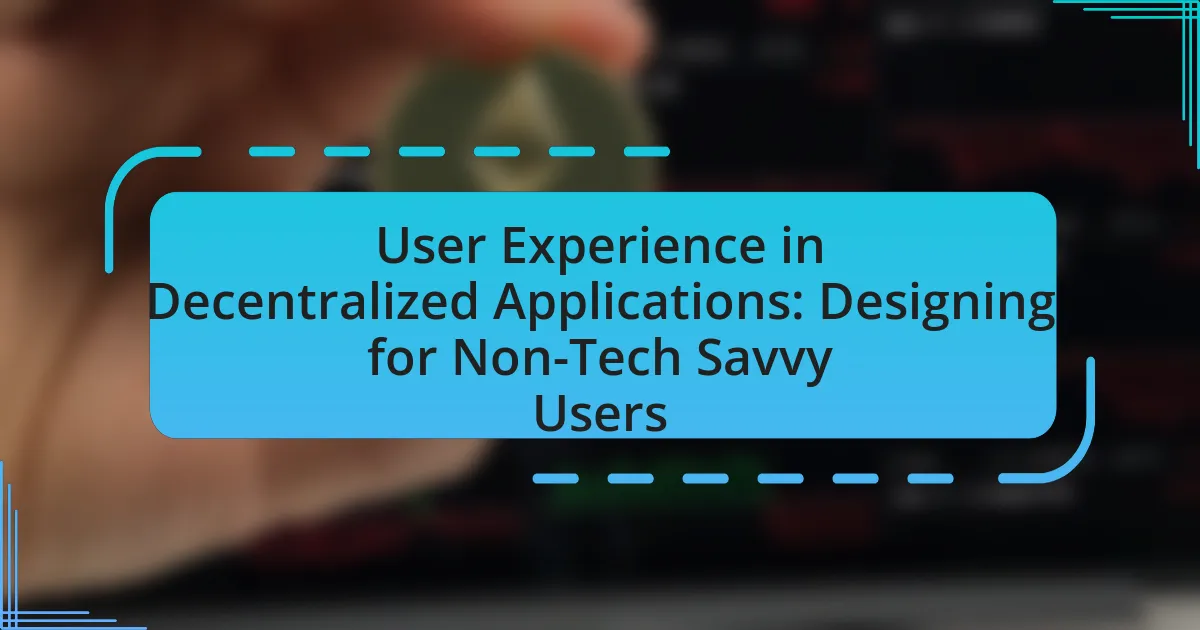A decentralized application (DApp) is a software application that operates on a blockchain or peer-to-peer network, utilizing smart contracts for secure and transparent transactions. This article provides a comprehensive guide on building your first DApp, covering essential topics such as the differences between DApps and traditional applications, key characteristics, technologies involved, and common use cases across various industries. It also outlines the steps for development, including choosing the right blockchain platform, programming languages, user interface design, testing, and deployment, while addressing challenges like scalability and security. Additionally, the article emphasizes the importance of community engagement and user feedback in ensuring the success of a DApp.
What is a Decentralized Application (DApp)?
A Decentralized Application (DApp) is a software application that runs on a blockchain or peer-to-peer network, rather than being hosted on centralized servers. DApps utilize smart contracts to facilitate transactions and operations, ensuring transparency and security. The decentralized nature of DApps allows them to operate without a single point of failure, making them resistant to censorship and fraud. According to the Ethereum Foundation, DApps can be categorized into three types: those that are fully decentralized, those that are partially decentralized, and those that are centralized but utilize blockchain for certain functions.
How do DApps differ from traditional applications?
DApps, or decentralized applications, differ from traditional applications primarily in their reliance on blockchain technology and decentralized networks. Traditional applications typically operate on centralized servers, which means they are controlled by a single entity, leading to potential vulnerabilities and single points of failure. In contrast, DApps run on a peer-to-peer network, ensuring that no single entity has control over the entire application, which enhances security and resilience against censorship. Furthermore, DApps often utilize smart contracts to automate processes and enforce rules without intermediaries, while traditional applications rely on centralized databases and servers for data management and processing. This fundamental difference in architecture and control mechanisms highlights the innovative nature of DApps compared to their traditional counterparts.
What are the key characteristics of DApps?
Decentralized applications (DApps) are characterized by their reliance on blockchain technology, which ensures transparency, security, and immutability. DApps operate on a peer-to-peer network, eliminating the need for a central authority, which enhances user control and privacy. They utilize smart contracts to automate processes and enforce rules without intermediaries, thereby reducing operational costs and increasing efficiency. Additionally, DApps are open-source, allowing developers to collaborate and innovate, while users can verify the code for trustworthiness. These characteristics collectively contribute to the robustness and appeal of DApps in the digital ecosystem.
Why is decentralization important in application development?
Decentralization is important in application development because it enhances security, increases transparency, and promotes user autonomy. By distributing data across multiple nodes rather than relying on a central server, decentralized applications reduce the risk of single points of failure and make it more difficult for malicious actors to compromise the system. Additionally, decentralization allows users to have greater control over their data, fostering trust and encouraging participation. Research indicates that decentralized systems can lead to improved resilience against attacks, as evidenced by the robust performance of blockchain technologies in various applications.
What technologies are used to build DApps?
DApps are built using several key technologies, primarily blockchain platforms, smart contracts, and decentralized storage solutions. Blockchain platforms like Ethereum provide the foundational infrastructure for DApps, enabling decentralized execution and consensus. Smart contracts, which are self-executing contracts with the terms directly written into code, facilitate automated transactions and interactions within DApps. Additionally, decentralized storage solutions such as IPFS (InterPlanetary File System) allow for data storage that is not reliant on a single server, enhancing the DApp’s resilience and accessibility. These technologies collectively enable the creation and operation of decentralized applications, ensuring security, transparency, and user control.
What role do blockchain and smart contracts play in DApps?
Blockchain serves as the foundational technology for decentralized applications (DApps), providing a secure, transparent, and immutable ledger for data storage and transactions. Smart contracts, which are self-executing contracts with the terms of the agreement directly written into code, automate processes within DApps, ensuring that actions are executed only when predefined conditions are met. This combination enhances trust and reduces the need for intermediaries, as all transactions are recorded on the blockchain and can be verified by any participant in the network. The Ethereum blockchain, for instance, is widely used for DApps due to its robust support for smart contracts, enabling developers to create complex decentralized applications that operate autonomously.
How do decentralized storage solutions work?
Decentralized storage solutions work by distributing data across multiple nodes in a network rather than relying on a single centralized server. This distribution enhances data redundancy and security, as files are broken into smaller pieces, encrypted, and stored across various locations. For instance, protocols like IPFS (InterPlanetary File System) utilize a peer-to-peer network to ensure that data remains accessible even if some nodes go offline. This method not only improves resilience against data loss but also reduces the risk of censorship, as no single entity controls the entire dataset.
What are the common use cases for DApps?
Common use cases for decentralized applications (DApps) include finance, gaming, supply chain management, and social networking. In finance, DApps enable decentralized finance (DeFi) platforms that allow users to lend, borrow, and trade assets without intermediaries, exemplified by protocols like Uniswap and Aave. In gaming, DApps facilitate ownership of in-game assets through non-fungible tokens (NFTs), as seen in games like Axie Infinity. Supply chain management DApps enhance transparency and traceability of goods, with projects like VeChain demonstrating this capability. Social networking DApps provide users with control over their data and privacy, illustrated by platforms like Steemit. These use cases highlight the versatility and potential of DApps across various industries.
Which industries are adopting DApps?
The industries adopting decentralized applications (DApps) include finance, gaming, supply chain management, healthcare, and real estate. In finance, DApps facilitate decentralized finance (DeFi) services, allowing users to lend, borrow, and trade without intermediaries. The gaming industry utilizes DApps for creating blockchain-based games that enable true ownership of in-game assets. Supply chain management benefits from DApps by enhancing transparency and traceability of goods. In healthcare, DApps are used for secure patient data management and sharing. Lastly, the real estate sector employs DApps for property transactions and management, streamlining processes and reducing fraud.
How do DApps enhance user privacy and security?
DApps enhance user privacy and security by utilizing decentralized networks that eliminate the need for a central authority to manage data. This decentralization means that user information is stored across multiple nodes, reducing the risk of data breaches and unauthorized access. Additionally, DApps often employ cryptographic techniques to secure transactions and user identities, ensuring that sensitive information remains confidential. For instance, Ethereum-based DApps use smart contracts to facilitate secure interactions without exposing user data to third parties. This architecture not only protects against hacking but also empowers users with greater control over their personal information, as they can choose what data to share and with whom.
What are the steps to build your first DApp?
To build your first decentralized application (DApp), follow these steps:
- Define the DApp’s purpose and functionality, ensuring it addresses a specific problem or need.
- Choose a blockchain platform, such as Ethereum, Binance Smart Chain, or Solana, based on your requirements for scalability and smart contract capabilities.
- Set up a development environment by installing necessary tools like Node.js, Truffle, or Hardhat, and a code editor such as Visual Studio Code.
- Write smart contracts using a programming language like Solidity, ensuring they encapsulate the logic of your DApp.
- Test the smart contracts thoroughly using testing frameworks to identify and fix any issues before deployment.
- Deploy the smart contracts to the chosen blockchain network, which may involve using tools like Remix or Truffle.
- Develop the front-end interface using web technologies like HTML, CSS, and JavaScript, integrating it with the smart contracts through libraries like Web3.js or Ethers.js.
- Connect the front-end to a wallet provider, such as MetaMask, to enable user interactions with the DApp.
- Conduct user testing to gather feedback and make necessary adjustments.
- Launch the DApp and promote it to attract users.
These steps provide a structured approach to creating a DApp, ensuring that all critical aspects are addressed for successful development and deployment.
How do you choose the right blockchain platform for your DApp?
To choose the right blockchain platform for your decentralized application (DApp), evaluate the platform’s scalability, security, and community support. Scalability is crucial as it determines how many transactions the platform can handle simultaneously; for instance, Ethereum can process around 30 transactions per second, while Solana can handle thousands. Security is vital to protect user data and assets; platforms like Bitcoin and Ethereum have robust security protocols due to their extensive testing and large user bases. Community support is essential for ongoing development and troubleshooting; platforms with active communities, such as Ethereum and Binance Smart Chain, provide valuable resources and support for developers.
What factors should you consider when selecting a blockchain?
When selecting a blockchain, consider scalability, security, consensus mechanism, and community support. Scalability refers to the blockchain’s ability to handle an increasing number of transactions efficiently; for instance, Ethereum 2.0 aims to improve scalability through sharding. Security involves the robustness of the blockchain against attacks, with Bitcoin being noted for its high security due to its proof-of-work consensus. The consensus mechanism, such as proof-of-stake or proof-of-work, affects transaction speed and energy consumption; for example, Cardano uses proof-of-stake to enhance efficiency. Lastly, community support is crucial for development and troubleshooting, as seen with the active communities surrounding Ethereum and Polkadot, which foster innovation and provide resources.
Which platforms are popular for DApp development?
Ethereum is the most popular platform for DApp development, known for its robust smart contract functionality and large developer community. Other notable platforms include Binance Smart Chain, which offers lower transaction fees and faster processing times, and Polkadot, which enables interoperability between different blockchains. Additionally, Solana is gaining traction due to its high throughput and low latency, making it suitable for scalable DApps. These platforms are widely recognized in the blockchain ecosystem for their unique features and capabilities that support decentralized application development.
What programming languages are essential for DApp development?
The essential programming languages for DApp development are Solidity, JavaScript, and Go. Solidity is primarily used for writing smart contracts on the Ethereum blockchain, making it crucial for DApp functionality. JavaScript is important for front-end development and interacting with smart contracts through libraries like Web3.js. Go is often used for building blockchain infrastructure and backend services, particularly in projects like Hyperledger Fabric. These languages collectively enable developers to create, deploy, and manage decentralized applications effectively.
How does Solidity differ from other programming languages?
Solidity differs from other programming languages primarily in its design for creating smart contracts on blockchain platforms, particularly Ethereum. Unlike general-purpose programming languages such as Python or Java, Solidity is statically typed and specifically tailored for the decentralized environment, enabling developers to define rules and execute transactions securely on the blockchain. Additionally, Solidity incorporates features like inheritance, libraries, and complex user-defined types, which are not typically emphasized in traditional programming languages. This specialization allows Solidity to facilitate the development of decentralized applications (dApps) that operate autonomously without intermediaries, a fundamental characteristic of blockchain technology.
What are the best practices for writing smart contracts?
The best practices for writing smart contracts include thorough testing, using established libraries, and implementing security measures. Thorough testing ensures that the contract behaves as expected under various conditions, reducing the risk of bugs. Utilizing established libraries, such as OpenZeppelin, helps developers avoid common pitfalls and leverage well-audited code. Implementing security measures, such as access control and proper error handling, protects against vulnerabilities like reentrancy attacks. According to a report by ConsenSys, 70% of smart contract vulnerabilities stem from coding errors, highlighting the importance of these best practices in ensuring the reliability and security of decentralized applications.
How do you design the user interface for your DApp?
To design the user interface for a DApp, prioritize user experience by ensuring intuitive navigation and clear functionality. This involves creating wireframes and prototypes that reflect the DApp’s core features, followed by user testing to gather feedback. Research indicates that user-centered design significantly enhances usability, as seen in studies where DApps with streamlined interfaces reported higher user satisfaction and engagement.
What tools can assist in creating a user-friendly interface?
Tools that can assist in creating a user-friendly interface include Figma, Adobe XD, and Sketch. These design tools enable developers and designers to create intuitive layouts and prototypes that enhance user experience. Figma allows for real-time collaboration, which is essential for teams working on decentralized applications. Adobe XD offers features like voice prototyping and responsive resize, making it easier to design for various devices. Sketch is known for its vector editing capabilities and extensive plugin ecosystem, which can streamline the design process. Each of these tools has been widely adopted in the industry, demonstrating their effectiveness in facilitating user-friendly interface design.
How do you ensure accessibility in your DApp design?
To ensure accessibility in DApp design, implement features such as screen reader compatibility, keyboard navigation, and color contrast adjustments. These elements allow users with disabilities to interact effectively with the application. Research indicates that approximately 15% of the global population experiences some form of disability, highlighting the importance of inclusive design practices. By adhering to Web Content Accessibility Guidelines (WCAG), developers can create a more user-friendly experience that accommodates diverse user needs.
What are the challenges in building a DApp?
Building a decentralized application (DApp) presents several challenges, including scalability, user experience, and security. Scalability issues arise because many blockchain networks struggle to handle a high volume of transactions efficiently, leading to slow processing times and increased costs. User experience can be hindered by the complexity of blockchain technology, making it difficult for non-technical users to interact with DApps. Security challenges are significant, as vulnerabilities in smart contracts can lead to exploits and loss of funds, evidenced by incidents like the DAO hack in 2016, where $60 million was stolen due to a flaw in the smart contract code. These factors collectively complicate the development and adoption of DApps.
What technical hurdles might you encounter during development?
During the development of a decentralized application (dApp), common technical hurdles include scalability issues, security vulnerabilities, and interoperability challenges. Scalability issues arise because many blockchain networks can handle only a limited number of transactions per second, which can lead to congestion and slow performance. For instance, Ethereum has faced significant scalability challenges, particularly during peak usage times, resulting in high gas fees and delayed transactions. Security vulnerabilities are critical as dApps are often targets for attacks, such as smart contract exploits, which can lead to significant financial losses; the DAO hack in 2016 is a notable example where vulnerabilities in smart contracts resulted in the loss of $60 million worth of Ether. Interoperability challenges occur when different blockchain networks cannot communicate effectively, limiting the functionality and user experience of the dApp; for example, a dApp built on Ethereum may struggle to interact with assets on the Bitcoin network without additional protocols or bridges.
How can you address scalability issues in your DApp?
To address scalability issues in your DApp, implement layer-2 solutions such as state channels or sidechains. These technologies allow transactions to be processed off the main blockchain, significantly increasing throughput and reducing congestion. For instance, the Lightning Network for Bitcoin and Optimistic Rollups for Ethereum have demonstrated improved scalability by enabling faster and cheaper transactions while maintaining security. Additionally, optimizing smart contracts for efficiency can further enhance performance, as seen in projects that have successfully reduced gas fees and execution times.
What security concerns should you be aware of?
When building a decentralized application (dApp), you should be aware of security concerns such as smart contract vulnerabilities, data privacy issues, and network attacks. Smart contracts can contain bugs or exploits that malicious actors can leverage, leading to financial losses; for instance, the DAO hack in 2016 resulted in a loss of $60 million due to a vulnerability in the smart contract code. Data privacy is also critical, as decentralized systems may expose user information if not properly encrypted. Additionally, network attacks, such as Distributed Denial of Service (DDoS) attacks, can disrupt the availability of your dApp, impacting user experience and trust.
How do you test and deploy your DApp?
To test and deploy a DApp, developers typically use a combination of testing frameworks and deployment tools. First, they conduct unit tests and integration tests using frameworks like Truffle or Hardhat, which allow for testing smart contracts in a simulated environment. After thorough testing, developers deploy the DApp to a blockchain network, often using tools like Infura or Alchemy for Ethereum, which facilitate interaction with the blockchain. This process ensures that the DApp functions correctly and securely before it goes live.
What testing frameworks are available for DApp development?
Testing frameworks available for DApp development include Truffle, Hardhat, and Ganache. Truffle is a widely used framework that provides a suite of tools for developing, testing, and deploying smart contracts. Hardhat offers a flexible environment for Ethereum development, including built-in testing capabilities and support for Solidity debugging. Ganache is a personal blockchain for Ethereum development that allows for quick testing of DApps in a controlled environment. These frameworks are essential for ensuring the reliability and functionality of decentralized applications.
How do you manage updates and maintenance post-deployment?
To manage updates and maintenance post-deployment, implement a structured process that includes regular monitoring, user feedback collection, and scheduled updates. Regular monitoring allows for the identification of issues and performance metrics, while user feedback helps prioritize necessary changes. Scheduled updates ensure that improvements and security patches are systematically applied, reducing vulnerabilities. According to a study by the National Institute of Standards and Technology, organizations that adopt a proactive maintenance strategy can reduce downtime by up to 30%, demonstrating the effectiveness of these practices in maintaining application performance and security.
What are the best practices for promoting your DApp?
The best practices for promoting your DApp include leveraging social media, engaging with the community, utilizing content marketing, and collaborating with influencers. Social media platforms like Twitter and Reddit are effective for reaching potential users and sharing updates. Engaging with the community through forums and discussion groups fosters trust and encourages user feedback. Content marketing, such as blogs and tutorials, educates users about the DApp’s features and benefits, enhancing visibility. Collaborating with influencers in the blockchain space can amplify reach and credibility, as they often have established audiences interested in decentralized applications. These strategies are supported by the fact that successful DApps often see increased user adoption through active community engagement and targeted marketing efforts.
How can you effectively market your DApp to users?
To effectively market your DApp to users, focus on building a strong online presence through targeted social media campaigns and community engagement. Utilizing platforms like Twitter, Reddit, and Telegram allows you to reach crypto enthusiasts and potential users directly. According to a report by DappRadar, DApps that actively engage with their communities see a 30% higher user retention rate. Additionally, leveraging influencer partnerships can amplify your reach, as influencers in the blockchain space often have established trust with their followers.
What role does community engagement play in DApp success?
Community engagement is crucial for the success of decentralized applications (DApps) as it fosters user trust, enhances adoption, and drives continuous improvement. Engaged communities provide valuable feedback, contribute to development, and promote the DApp through word-of-mouth, which can significantly increase user base and activity. For instance, successful DApps like Uniswap and Aave have built strong communities that actively participate in governance and feature suggestions, leading to sustained growth and innovation.
What common mistakes should you avoid when building a DApp?
Common mistakes to avoid when building a DApp include neglecting user experience, failing to secure smart contracts, and not considering scalability. Neglecting user experience can lead to low adoption rates, as users may find the interface confusing or cumbersome. Failing to secure smart contracts can result in vulnerabilities that hackers can exploit, leading to significant financial losses; for instance, the DAO hack in 2016 resulted in the loss of $60 million due to a smart contract flaw. Not considering scalability can hinder the DApp’s performance during peak usage times, as seen with Ethereum’s congestion issues during high-demand periods.
How can you ensure compliance with regulations in your DApp?
To ensure compliance with regulations in your DApp, conduct thorough research on applicable laws and regulations in your jurisdiction, such as data protection, anti-money laundering, and securities laws. This involves consulting legal experts who specialize in blockchain technology and regulatory frameworks to interpret how these laws apply to your specific application. Additionally, implementing robust security measures and transparent governance structures can help demonstrate compliance. For instance, adhering to the General Data Protection Regulation (GDPR) in the European Union requires explicit user consent for data processing, which can be achieved through clear user agreements and privacy policies.
What are the pitfalls of neglecting user feedback?
Neglecting user feedback can lead to significant pitfalls, including the development of features that do not meet user needs, resulting in low adoption rates. When developers ignore user insights, they risk creating a product that lacks relevance, which can ultimately lead to wasted resources and time. Additionally, failure to address user concerns can damage brand reputation and user trust, as evidenced by studies showing that 70% of customers are more likely to remain loyal to brands that actively seek and respond to feedback. This neglect can also hinder innovation, as user feedback often serves as a catalyst for new ideas and improvements.
What resources are available for aspiring DApp developers?
Aspiring DApp developers can access a variety of resources including online courses, documentation, and community forums. Platforms like Coursera and Udemy offer structured courses on blockchain and DApp development, while Ethereum’s official documentation provides essential guidelines and technical references. Additionally, GitHub hosts numerous open-source projects that serve as practical examples, and forums like Stack Overflow and Reddit’s r/ethdev community facilitate peer support and knowledge sharing. These resources collectively enhance the learning experience and provide practical insights into DApp development.
Which online courses and tutorials are recommended for learning DApp development?
Recommended online courses for learning DApp development include “Ethereum and Solidity: The Complete Developer’s Guide” on Udemy, which covers building DApps using Ethereum and Solidity, and “Blockchain Developer Bootcamp” on Coursera, offering a comprehensive overview of blockchain technology and DApp development. Additionally, the “DApp University” YouTube channel provides free tutorials and practical examples for aspiring developers. These resources are widely recognized for their structured content and practical applications in the field of decentralized application development.
How can you leverage developer communities for support?
You can leverage developer communities for support by actively participating in forums, social media groups, and online platforms dedicated to development topics. Engaging with these communities allows you to ask questions, share your challenges, and receive feedback from experienced developers. For instance, platforms like Stack Overflow and GitHub have vast user bases where developers frequently offer assistance and share resources. Research indicates that 70% of developers find community support invaluable for problem-solving and learning new skills, highlighting the effectiveness of these interactions in enhancing your development journey.
